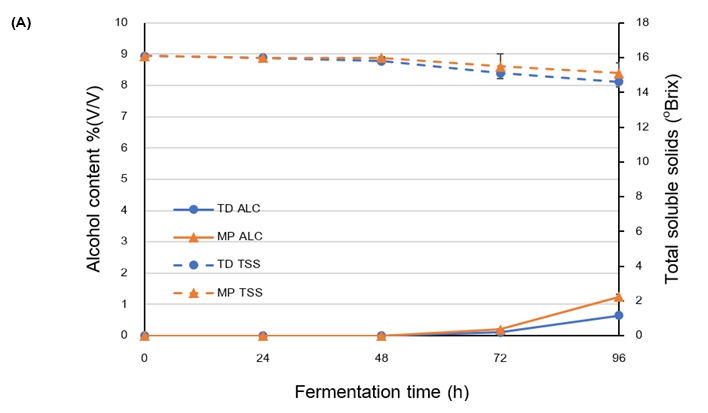Effect of Torulaspora delbrueckii and Metschnikowia pulcherrima on Fermentation Activities and Sensory Properties of Sparkling Lychee (Litchi chinensis Sonn. var. Hong Huay) Cider
Keywords:
Sparkling lychee cider, Torulaspora delbrueckii, Metschnikowia pulcherrima, Fermentation activity, Sensory propertyAbstract
This research used the low selling price and short shelf-life of lychee fruit drop as raw materials for sparkling lychee cider production. Lychee juices were fermented with two strains of non-Saccharomyces yeasts (Torulaspora delbrueckii; TD and Metschnikowia pulcherrima; MP) in hermetically sealed glass bottles and incubated at ambient temperature (30±3 °C) for 96 h. Fermentation activities were monitored every 24 h. It was found that TD yeast started fermenting faster than MP yeast, with lower conversion rate of sugar to alcohol and carbon dioxide. Sparkling lychee cider fermented with TD yeast had higher sensory scores of tropical fruit aroma intensity, aroma, -flavor, and -overall liking than that of sparkling lychee cider fermented with MP yeast.
References
Office of Agricultural Economics. [internet]. Accessed 2022 March 13. Available from: http://mis- app.oae.go.th/product/%E0%B8%A5%E0%B8%B4%E0%B9%89%E0%B8%99%E0%B8%88% E0%B8%B5%E0%B9%88.
Bangkokbiznews [internet]. Accessed 2022 May 5. Available from: https://www.bangkokbiznews.com/news/1002717.
Panee Sirisa-ard [internet]. Accessed 2021 December 24. Available from: https://www.pharmacy.cmu.ac.th/web2553/n56.php.
Joshi VK, Attri BL. Chapter 7 Specific features of table wine production. In: Kosseva M, Joshi VK, Panesar PS. Science and technology of fruit wine production. 1sted, 318-319. London, UK: Elsevier, Inc.; 2017.
Jarvis B. Cider (Cyder; Hard Cider). In: Batt CA, Tortorello ML. Encyclopedia of food sciences and nutrition, vol 1. 2nd ed, 437–443. Ross-on-Wye, UK: Elsevier, Inc.; 2014.
Mahannopkul W, Inprasit K. Banana cider production. Bull Dept Sci Ser. 2012;60(188):8-9.
Lobo AP, García DY, MangasSánchez J, Madrera RR, SuárezValles B. Phenolic and antioxidant composition of cider. J Food Compos Anal. 2009;22(7–8):644-648.
Zuriarrain A, Zuriarrain J, Puertas IA, Dueñas TM, Ostra M, Berregi I. Polyphenolic profile in cider and antioxidant power. J Sci Food Agric. 2015;95(14):2931-2943.
Allied Market Research [internet]. Accessed 2019 October 25. Available from: https://www.alliedmarketresearch.com/cider-market.
Yongpisanphob W [internet]. Accessed 2019 May 3. Available from: https://www.krungsri.com/th / research/industry/industry-outlook/Food-Beverage/Beverage/IO/io-beverage-20-th.
Alicia G, Teun B, Zoran G, Michael K. Evaluation of non-Saccharomyces yeasts in the fermentation of wine, beer and cider for the development of new beverages. J Inst Brew. 2018;124:389–402.
Sgouros G, Chalvantzi I, Mallouchos A, Paraskevopoulos Y, Banilas G, Nisiotou A. Biodiversity and enological potential of non-Saccharomyces yeasts from Nemean vineyards. Fermentation. 2018;4(32):1-13.
Kręgiel D, Pawlikowska E, Antolak H, Dziekońska-Kubczak U, Pielech-Przybylska K. Exploring use of the Metschnikowia pulcherrima clade to improve properties of fruit wines. Fermentation. 2022;8(247):1-16.
Zhang B, Liu H, Xue J, Tang C, Duan C, Yan G. Use of Torulaspora delbrueckii and Hanseniaspora vineae co-fermentation with Saccharomyces cerevisiae to improve aroma profiles and safety quality of Petit Manseng wines. LWT. 2022;161(113360):1-8.
Karabegović I, Malićanin M, Danilovic B, Stanojevic J, Stojanovic SS, Nikolic N, Lazic M. Potential of non-Saccharomyces yeast for improving the aroma and sensory profile of Prokupac red wine. IVES. 2021;2:181-195.
González-R. E, Pascual O, Kontoudakis N, Esteruelas M, Esteve-Z B, Mas A, Canals JM, Zamora F. Oenological consequences of sequential inoculation with non-Saccharomyces yeasts (Torulaspora delbrueckii or Metschnikowia pulcherrima) and Saccharomyces cerevisiae in base wine for sparkling wine production. Eur Food Res Technol. 2015;240:999–1012.
Sadineni V, Kondapalli N, Obulam VSR. Effect of co-fermentation with Saccharomyces cerevisiae and Torulaspora delbrueckii or Metschnikowia pulcherrima on the aroma and sensory properties of mango wine. Ann Microbiol. 2012;62:1353–1360.
Einfalt D. Barley‑sorghum craft beer production with Saccharomyces cerevisiae, Torulaspora delbrueckii and Metschnikowia pulcherrima yeast strains. Eur Food Res Technol. 2021;247:385–393.
Bely M, Stoeckle P, Masneuf-Pomarède I, Dubourdieu D. Impact of mixed Torulaspora delbrueckii–Saccharomyces cerevisiae culture on high-sugar fermentation. Int J Food Microbiol. 2008;122:312–320.
Dutraive O, Benito S, Fritsch S, Beisert B, Patz C, Rauhut D. Effect of Sequential Inoculation with Non-Saccharomyces and Saccharomyces Yeasts on Riesling Wine Chemical Composition. Fermentation. 2019;5(79):1-16.
AOAC. Official methods of analysis. Association of official chemist. Washington; 1995.
Civille GV, Carr BT. Sensory evaluation techniques. 5th ed, 630. Boca Raton: CRC Press; 2015.
Ribereau-Gayon P, Glories Y, Maujean A, Dubourdieu D. Chapter 1 Organic Acids in Wine. In: andbook of enology volume 2; The chemistry of wine stabilization and treatments. 2nd ed, 451. West Sussex, UK: John Wiley & Sons Ltd.; 2006.
The Australian Wine Research Institute [internet]. Accessed 2021 October 10. Available from:
https://www.awri.com.au/industry_support/winemaking_resources/frequently_asked_questions/acidity_ and_ph/
Morata A, Loira I, Escott C, Fresno JM, Bañuelos MA, Lepe JAS. Applications of Metschnikowia pulcherrima in wine biotechnology. Fermentation. 2019;5(63):1-9.
Benito S. The impact of Torulaspora delbrueckii yeast in winemaking. Appl Microbiol Biotechnol. 2018;102:3081–3094.
Jolly NP, Augustyn OPH, Pretorius IS. The role and use of non-Saccharomyces yeasts in wine Production. S Afr J Enol Vitic. 2006;27(1):15-38.
Feng CT, Du X, Wee J. Microbial and chemical analysis of non-Saccharomyces yeasts from
Chambourcin hybrid grapes for potential use in winemaking, Fermentation. 2021;7(15):1-23.
Chen K, Escott C, Loira I, del Fresno JM, Morata A, Tesfaye W, Calderon F, Suárez-Lepe JA, Han S, Benito S. Use of non-Saccharomyces yeasts and oenological tannin in red winemaking: influence on colour, aroma and sensorial properties of young wines. Food Microbiol. 2018;69:51–63.
Chen D, Liu S-Q. Impact of simultaneous and sequential fermentation with Torulaspora delbrueckii and Saccharomyces cerevisiae on non-volatiles and volatiles of lychee wines. LWT-Food Sci Technol. 2016;65:53–61.
Panjai L, Ongthip K, Chomsri N. Complex fruit wine produced from dual culture fermentation of pineapple juice with Torulaspora delbrueckii and Saccharomyces cerevisiae. As J Food Ag-Ind. 2009; 2(02):135-139.

Downloads
Published
How to Cite
Issue
Section
License
Copyright (c) 2023 University of Phayao

This work is licensed under a Creative Commons Attribution-NonCommercial-NoDerivatives 4.0 International License.
ผู้นิพนธ์ต้องรับผิดชอบข้อความในบทนิพนธ์ของตน มหาวิทยาลัยพะเยาไม่จำเป็นต้องเห็นด้วยกับบทความที่ตีพิมพ์เสมอไป ผู้สนใจสามารถคัดลอก และนำไปใช้ได้ แต่จะต้องขออนุมัติเจ้าของ และได้รับการอนุมัติเป็นลายลักษณ์อักษรก่อน พร้อมกับมีการอ้างอิงและกล่าวคำขอบคุณให้ถูกต้องด้วย
The authors are themselves responsible for their contents. Signed articles may not always reflect the opinion of University of Phayao. The articles can be reproduced and reprinted, provided that permission is given by the authors and acknowledgement must be given.







